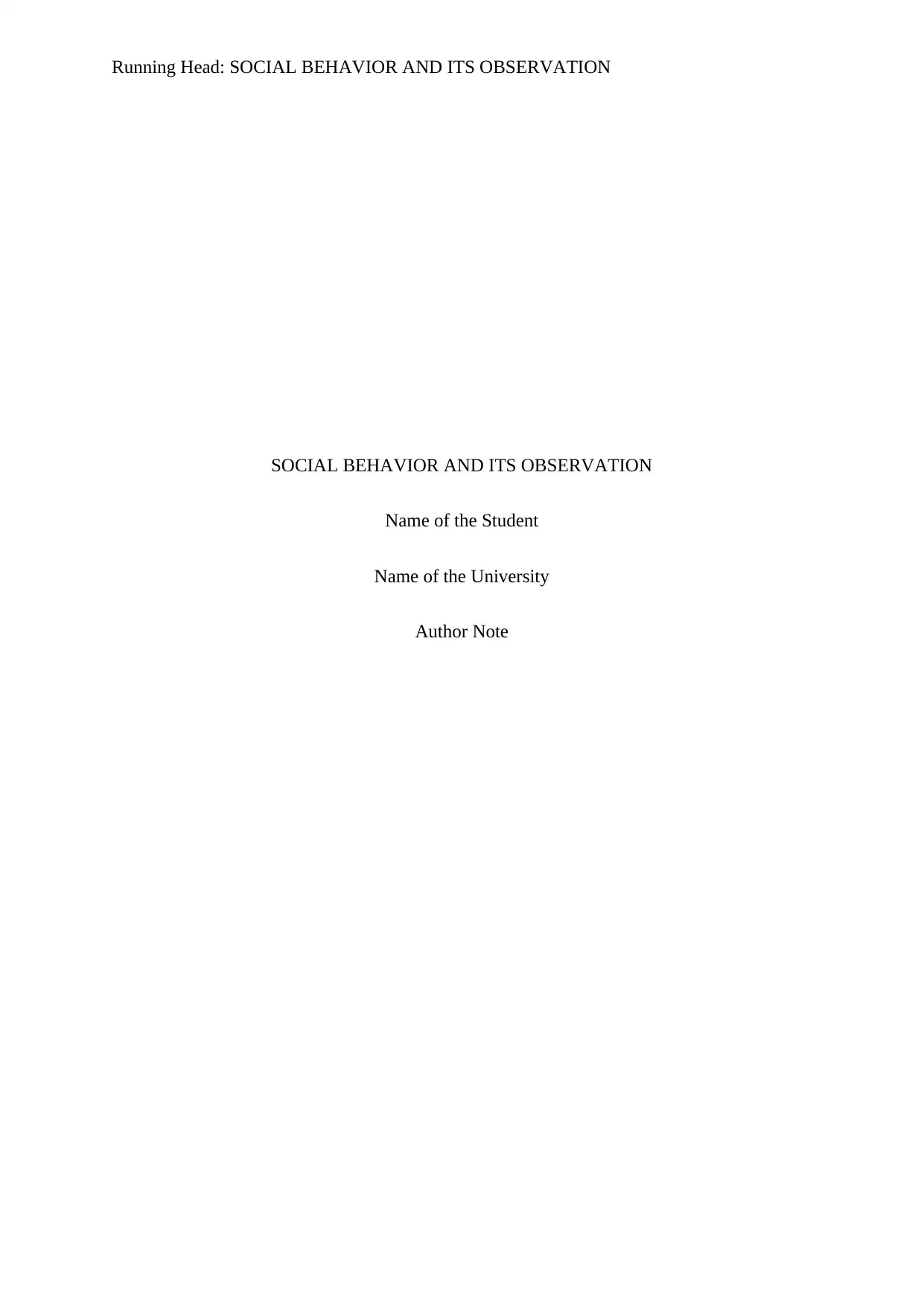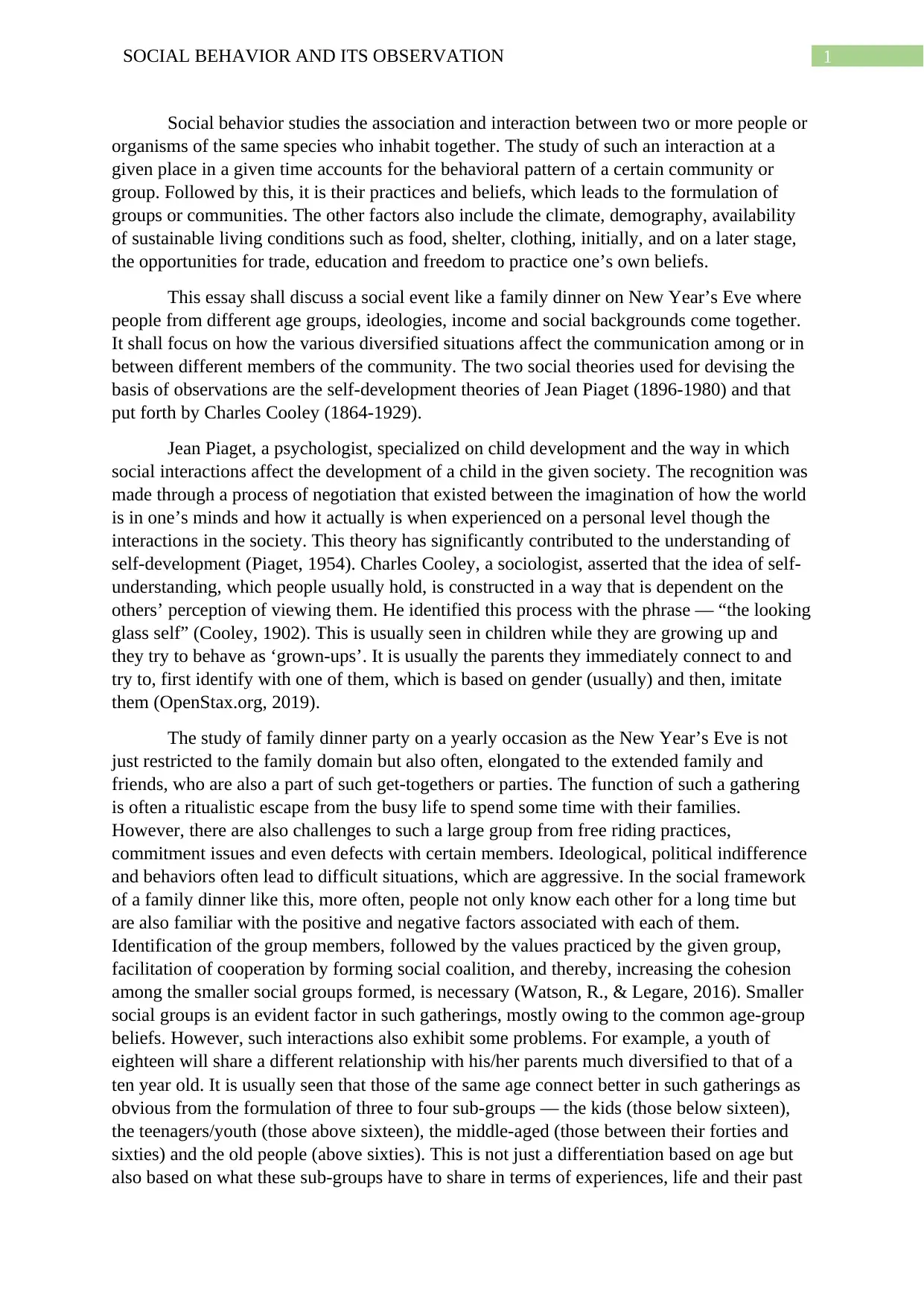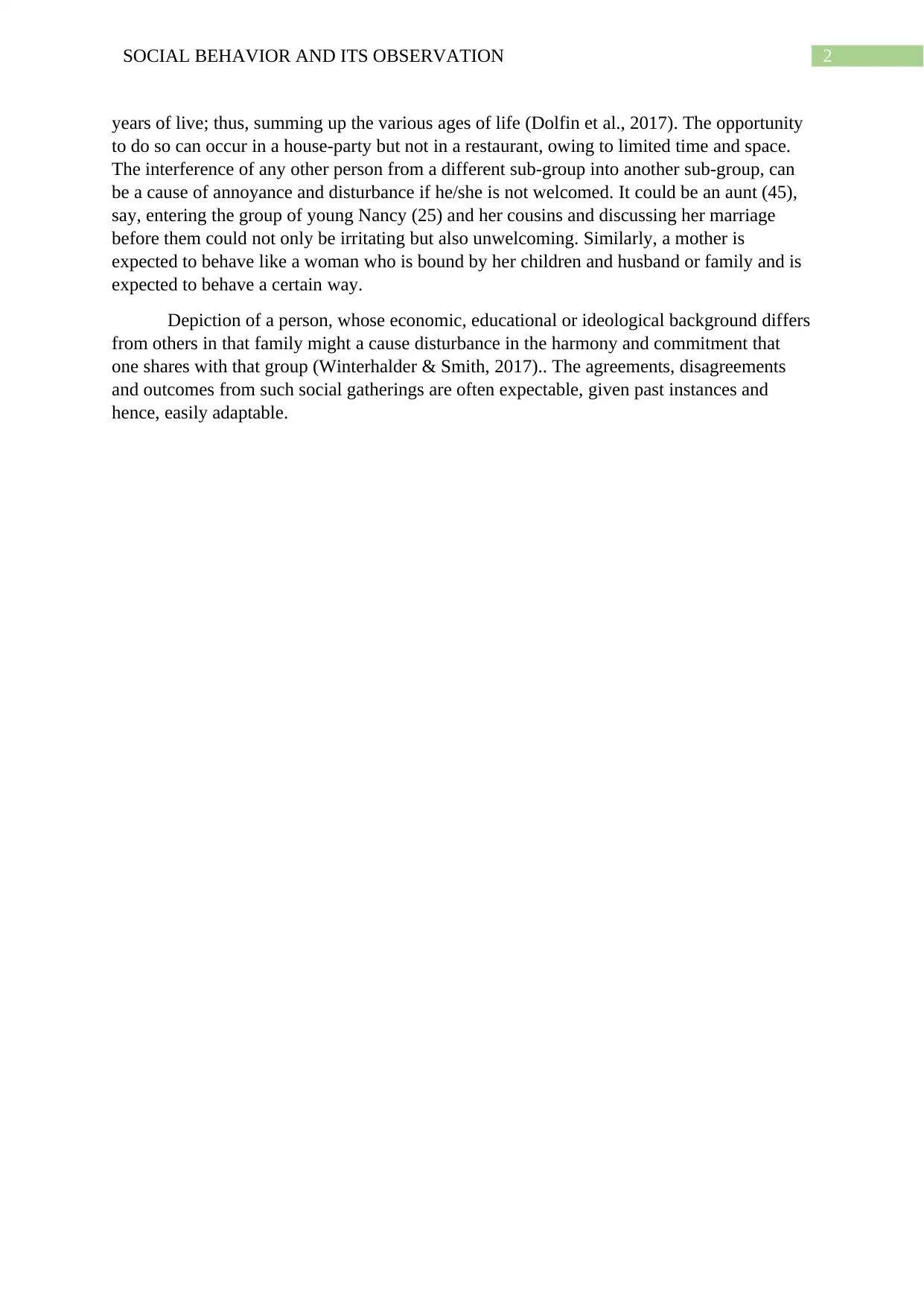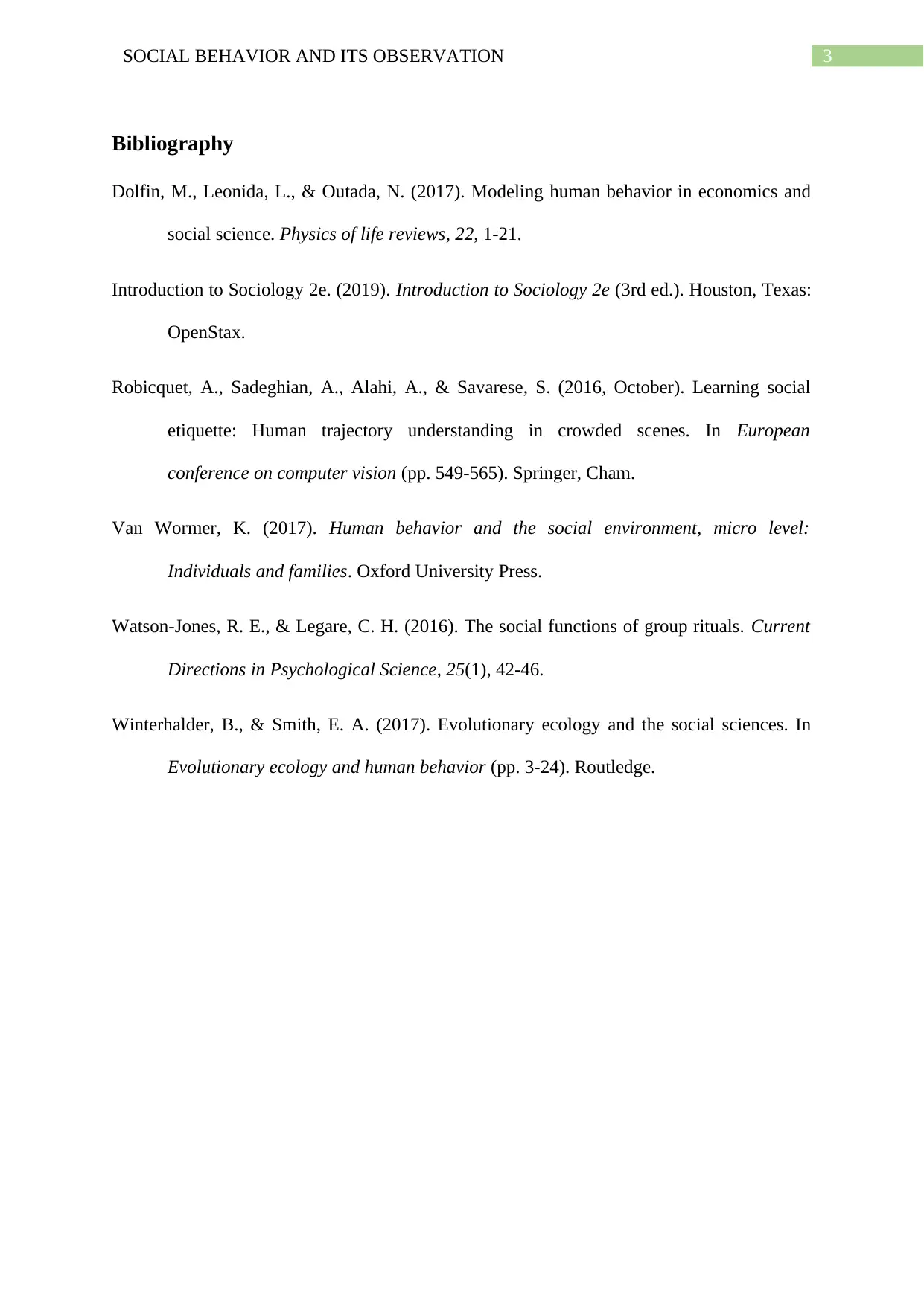Analysis of Social Behavior: Family Dinner Observation Report
VerifiedAdded on 2022/10/19
|4
|1190
|398
Report
AI Summary
This report presents an analysis of social behavior observed during a New Year's Eve family dinner, incorporating sociological theories and concepts. The student observed interactions among family members of varying ages, ideologies, and backgrounds. The report discusses how different factors influence communication and group dynamics, including the impact of age, shared experiences, and differing perspectives. It applies the self-development theories of Jean Piaget and Charles Cooley's 'looking glass self' to understand how individuals perceive themselves within the social setting. The analysis highlights the formation of subgroups, potential conflicts arising from differing backgrounds, and the influence of past experiences on social interactions. The report examines issues like free-riding, commitment, and ideological differences, providing insights into the complexities of family gatherings and social behavior.

Running Head: SOCIAL BEHAVIOR AND ITS OBSERVATION
SOCIAL BEHAVIOR AND ITS OBSERVATION
Name of the Student
Name of the University
Author Note
SOCIAL BEHAVIOR AND ITS OBSERVATION
Name of the Student
Name of the University
Author Note
Paraphrase This Document
Need a fresh take? Get an instant paraphrase of this document with our AI Paraphraser

1SOCIAL BEHAVIOR AND ITS OBSERVATION
Social behavior studies the association and interaction between two or more people or
organisms of the same species who inhabit together. The study of such an interaction at a
given place in a given time accounts for the behavioral pattern of a certain community or
group. Followed by this, it is their practices and beliefs, which leads to the formulation of
groups or communities. The other factors also include the climate, demography, availability
of sustainable living conditions such as food, shelter, clothing, initially, and on a later stage,
the opportunities for trade, education and freedom to practice one’s own beliefs.
This essay shall discuss a social event like a family dinner on New Year’s Eve where
people from different age groups, ideologies, income and social backgrounds come together.
It shall focus on how the various diversified situations affect the communication among or in
between different members of the community. The two social theories used for devising the
basis of observations are the self-development theories of Jean Piaget (1896-1980) and that
put forth by Charles Cooley (1864-1929).
Jean Piaget, a psychologist, specialized on child development and the way in which
social interactions affect the development of a child in the given society. The recognition was
made through a process of negotiation that existed between the imagination of how the world
is in one’s minds and how it actually is when experienced on a personal level though the
interactions in the society. This theory has significantly contributed to the understanding of
self-development (Piaget, 1954). Charles Cooley, a sociologist, asserted that the idea of self-
understanding, which people usually hold, is constructed in a way that is dependent on the
others’ perception of viewing them. He identified this process with the phrase — “the looking
glass self” (Cooley, 1902). This is usually seen in children while they are growing up and
they try to behave as ‘grown-ups’. It is usually the parents they immediately connect to and
try to, first identify with one of them, which is based on gender (usually) and then, imitate
them (OpenStax.org, 2019).
The study of family dinner party on a yearly occasion as the New Year’s Eve is not
just restricted to the family domain but also often, elongated to the extended family and
friends, who are also a part of such get-togethers or parties. The function of such a gathering
is often a ritualistic escape from the busy life to spend some time with their families.
However, there are also challenges to such a large group from free riding practices,
commitment issues and even defects with certain members. Ideological, political indifference
and behaviors often lead to difficult situations, which are aggressive. In the social framework
of a family dinner like this, more often, people not only know each other for a long time but
are also familiar with the positive and negative factors associated with each of them.
Identification of the group members, followed by the values practiced by the given group,
facilitation of cooperation by forming social coalition, and thereby, increasing the cohesion
among the smaller social groups formed, is necessary (Watson, R., & Legare, 2016). Smaller
social groups is an evident factor in such gatherings, mostly owing to the common age-group
beliefs. However, such interactions also exhibit some problems. For example, a youth of
eighteen will share a different relationship with his/her parents much diversified to that of a
ten year old. It is usually seen that those of the same age connect better in such gatherings as
obvious from the formulation of three to four sub-groups — the kids (those below sixteen),
the teenagers/youth (those above sixteen), the middle-aged (those between their forties and
sixties) and the old people (above sixties). This is not just a differentiation based on age but
also based on what these sub-groups have to share in terms of experiences, life and their past
Social behavior studies the association and interaction between two or more people or
organisms of the same species who inhabit together. The study of such an interaction at a
given place in a given time accounts for the behavioral pattern of a certain community or
group. Followed by this, it is their practices and beliefs, which leads to the formulation of
groups or communities. The other factors also include the climate, demography, availability
of sustainable living conditions such as food, shelter, clothing, initially, and on a later stage,
the opportunities for trade, education and freedom to practice one’s own beliefs.
This essay shall discuss a social event like a family dinner on New Year’s Eve where
people from different age groups, ideologies, income and social backgrounds come together.
It shall focus on how the various diversified situations affect the communication among or in
between different members of the community. The two social theories used for devising the
basis of observations are the self-development theories of Jean Piaget (1896-1980) and that
put forth by Charles Cooley (1864-1929).
Jean Piaget, a psychologist, specialized on child development and the way in which
social interactions affect the development of a child in the given society. The recognition was
made through a process of negotiation that existed between the imagination of how the world
is in one’s minds and how it actually is when experienced on a personal level though the
interactions in the society. This theory has significantly contributed to the understanding of
self-development (Piaget, 1954). Charles Cooley, a sociologist, asserted that the idea of self-
understanding, which people usually hold, is constructed in a way that is dependent on the
others’ perception of viewing them. He identified this process with the phrase — “the looking
glass self” (Cooley, 1902). This is usually seen in children while they are growing up and
they try to behave as ‘grown-ups’. It is usually the parents they immediately connect to and
try to, first identify with one of them, which is based on gender (usually) and then, imitate
them (OpenStax.org, 2019).
The study of family dinner party on a yearly occasion as the New Year’s Eve is not
just restricted to the family domain but also often, elongated to the extended family and
friends, who are also a part of such get-togethers or parties. The function of such a gathering
is often a ritualistic escape from the busy life to spend some time with their families.
However, there are also challenges to such a large group from free riding practices,
commitment issues and even defects with certain members. Ideological, political indifference
and behaviors often lead to difficult situations, which are aggressive. In the social framework
of a family dinner like this, more often, people not only know each other for a long time but
are also familiar with the positive and negative factors associated with each of them.
Identification of the group members, followed by the values practiced by the given group,
facilitation of cooperation by forming social coalition, and thereby, increasing the cohesion
among the smaller social groups formed, is necessary (Watson, R., & Legare, 2016). Smaller
social groups is an evident factor in such gatherings, mostly owing to the common age-group
beliefs. However, such interactions also exhibit some problems. For example, a youth of
eighteen will share a different relationship with his/her parents much diversified to that of a
ten year old. It is usually seen that those of the same age connect better in such gatherings as
obvious from the formulation of three to four sub-groups — the kids (those below sixteen),
the teenagers/youth (those above sixteen), the middle-aged (those between their forties and
sixties) and the old people (above sixties). This is not just a differentiation based on age but
also based on what these sub-groups have to share in terms of experiences, life and their past

2SOCIAL BEHAVIOR AND ITS OBSERVATION
years of live; thus, summing up the various ages of life (Dolfin et al., 2017). The opportunity
to do so can occur in a house-party but not in a restaurant, owing to limited time and space.
The interference of any other person from a different sub-group into another sub-group, can
be a cause of annoyance and disturbance if he/she is not welcomed. It could be an aunt (45),
say, entering the group of young Nancy (25) and her cousins and discussing her marriage
before them could not only be irritating but also unwelcoming. Similarly, a mother is
expected to behave like a woman who is bound by her children and husband or family and is
expected to behave a certain way.
Depiction of a person, whose economic, educational or ideological background differs
from others in that family might a cause disturbance in the harmony and commitment that
one shares with that group (Winterhalder & Smith, 2017).. The agreements, disagreements
and outcomes from such social gatherings are often expectable, given past instances and
hence, easily adaptable.
years of live; thus, summing up the various ages of life (Dolfin et al., 2017). The opportunity
to do so can occur in a house-party but not in a restaurant, owing to limited time and space.
The interference of any other person from a different sub-group into another sub-group, can
be a cause of annoyance and disturbance if he/she is not welcomed. It could be an aunt (45),
say, entering the group of young Nancy (25) and her cousins and discussing her marriage
before them could not only be irritating but also unwelcoming. Similarly, a mother is
expected to behave like a woman who is bound by her children and husband or family and is
expected to behave a certain way.
Depiction of a person, whose economic, educational or ideological background differs
from others in that family might a cause disturbance in the harmony and commitment that
one shares with that group (Winterhalder & Smith, 2017).. The agreements, disagreements
and outcomes from such social gatherings are often expectable, given past instances and
hence, easily adaptable.
⊘ This is a preview!⊘
Do you want full access?
Subscribe today to unlock all pages.

Trusted by 1+ million students worldwide

3SOCIAL BEHAVIOR AND ITS OBSERVATION
Bibliography
Dolfin, M., Leonida, L., & Outada, N. (2017). Modeling human behavior in economics and
social science. Physics of life reviews, 22, 1-21.
Introduction to Sociology 2e. (2019). Introduction to Sociology 2e (3rd ed.). Houston, Texas:
OpenStax.
Robicquet, A., Sadeghian, A., Alahi, A., & Savarese, S. (2016, October). Learning social
etiquette: Human trajectory understanding in crowded scenes. In European
conference on computer vision (pp. 549-565). Springer, Cham.
Van Wormer, K. (2017). Human behavior and the social environment, micro level:
Individuals and families. Oxford University Press.
Watson-Jones, R. E., & Legare, C. H. (2016). The social functions of group rituals. Current
Directions in Psychological Science, 25(1), 42-46.
Winterhalder, B., & Smith, E. A. (2017). Evolutionary ecology and the social sciences. In
Evolutionary ecology and human behavior (pp. 3-24). Routledge.
Bibliography
Dolfin, M., Leonida, L., & Outada, N. (2017). Modeling human behavior in economics and
social science. Physics of life reviews, 22, 1-21.
Introduction to Sociology 2e. (2019). Introduction to Sociology 2e (3rd ed.). Houston, Texas:
OpenStax.
Robicquet, A., Sadeghian, A., Alahi, A., & Savarese, S. (2016, October). Learning social
etiquette: Human trajectory understanding in crowded scenes. In European
conference on computer vision (pp. 549-565). Springer, Cham.
Van Wormer, K. (2017). Human behavior and the social environment, micro level:
Individuals and families. Oxford University Press.
Watson-Jones, R. E., & Legare, C. H. (2016). The social functions of group rituals. Current
Directions in Psychological Science, 25(1), 42-46.
Winterhalder, B., & Smith, E. A. (2017). Evolutionary ecology and the social sciences. In
Evolutionary ecology and human behavior (pp. 3-24). Routledge.
1 out of 4
Related Documents
Your All-in-One AI-Powered Toolkit for Academic Success.
+13062052269
info@desklib.com
Available 24*7 on WhatsApp / Email
![[object Object]](/_next/static/media/star-bottom.7253800d.svg)
Unlock your academic potential
Copyright © 2020–2025 A2Z Services. All Rights Reserved. Developed and managed by ZUCOL.




